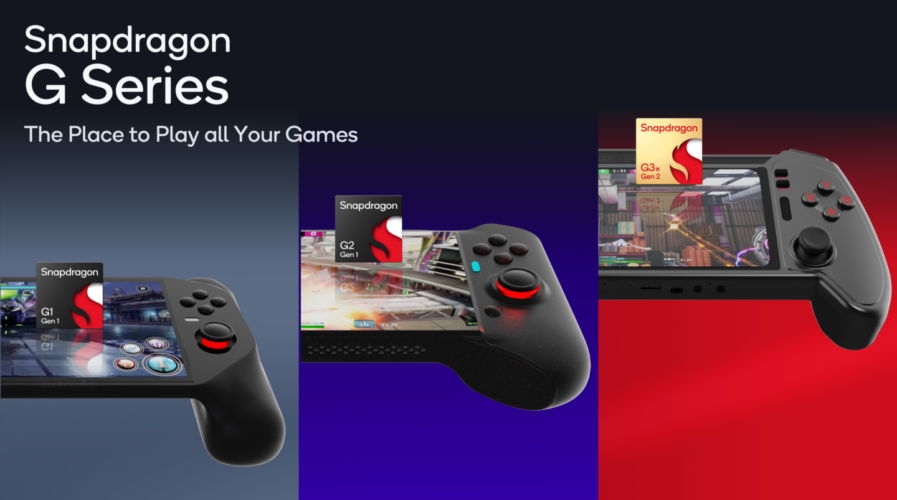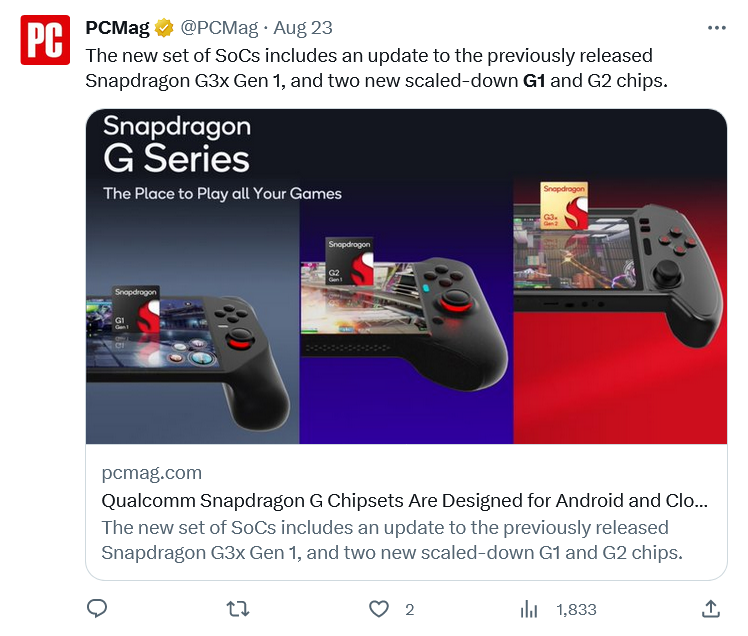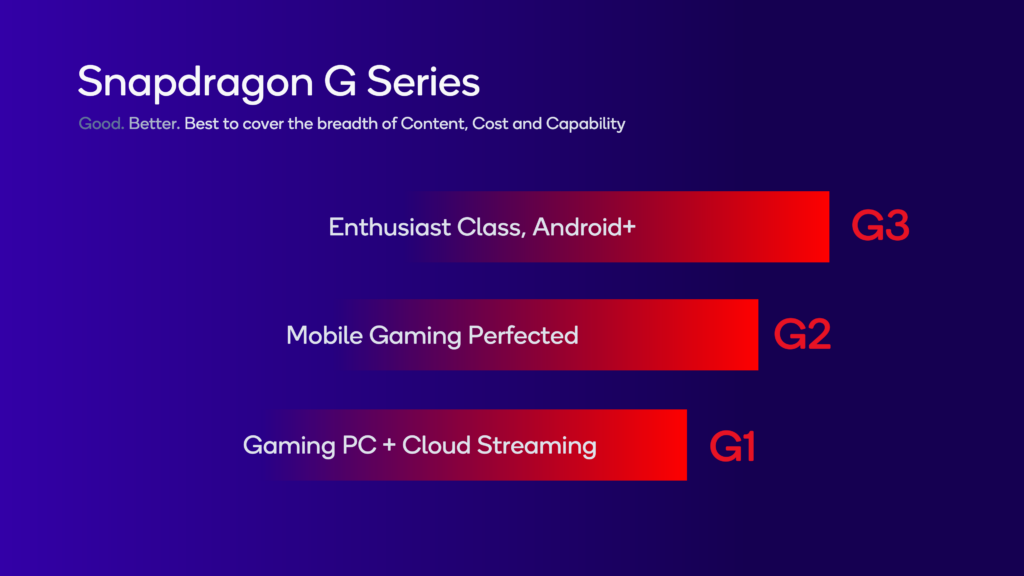
New Snapdragon G Series Platforms to revolutionize handheld gaming. (Source – Qualcomm)
Qualcomm vs MediaTek: Who will power the future of handheld gaming?
- Qualcomm’s gaming lineup now includes G1, G2, and G3 tiers, featuring the new enthusiast-grade G3x Gen 2 Platform.
- AyaNeo, Huaqin, Inventec, and Thundercomm are the firms teaming up with Qualcomm for Snapdragon-powered handheld gaming.
- The new chips speak of a more integrated, anytime, anywhere gaming future.
Even though the latest Android smartphones can easily handle popular games from the Play Store as well as nostalgic emulators, there’s something uniquely captivating about a device engineered for gaming. This niche charm has catapulted platforms like Nintendo Switch into the limelight, tempting major tech players like Razer and Logitech to venture into handheld gaming.
Making waves in this dynamic landscape is Ayaneo’s upcoming launch of Pocket AIR, an Android gaming device aimed at satiating the appetites of gaming enthusiasts. Although Ayaneo’s heritage is rooted in crafting Windows-based gaming gadgets, the company is broadening its horizons by exploring the untapped potential within the Android gaming ecosystem.
At least for now, the Ayaneo Pocket AIR’s engine room will feature MediaTek’s Dimensity 1200 chipset. This could soon be eclipsed by the new lineup of specialized gaming processors from Qualcomm that’s taking the stage.
Qualcomm’s triple threat: Introducing the Snapdragon G1, G2, and G3
Closing out 2021, Qualcomm set the bar high by rolling out its Snapdragon G3x Gen 1, which has found a home in flagship devices such as the Razer Edge. Far from resting on its laurels though, Qualcomm is upping the ante by unveiling not one, but three groundbreaking processors designed to redefine handheld gaming as we know it.
- The Snapdragon G1 aims to energize fanless handheld devices made primarily for game streaming, be it locally or through cloud services. With a focus on seamless connectivity and extended battery life, the G1 allows for high-quality streaming of console and PC games. The platform’s inaugural model, the Snapdragon G1 Gen 1, features an 8-core Qualcomm Kryo CPU and a Qualcomm Adreno A11 GPU.
- The Snapdragon G2 is engineered for uncompromising mobile and cloud gaming experiences. It comes equipped with state-of-the-art 5G and Wi-Fi 6/6E capabilities, thanks to the Qualcomm FastConnect 6700 Mobile Connectivity System. Its first iteration, the Snapdragon G2 Gen 1, combines the latest 8-core Kryo CPU with an Adreno A21 GPU and the Snapdragon X62 5G Modem-RF System.
- The Snapdragon G3 is the premium tier, developed with gaming fans in mind. Building on positive reviews from its earlier version used in the Razer Edge 5G, the new Snapdragon G3x Gen 2 platform showcases significant upgrades. These include a 30% faster CPU, a GPU that’s twice as fast, and advanced features like hardware-accelerated ray tracing and Wi-Fi 7 High-Band Simultaneous (HBS) support.
Qualcomm has made the Snapdragon G3x Gen 2 handheld gaming reference design available for select manufacturers to expedite the production of next-gen handheld gaming devices. Details on specific products from these partnerships will be announced soon.

The new Qualcomm gaming processors.
Mithun Chandrasekhar, Senior Director of Product Management at Qualcomm Technologies, explained that “Dedicated handheld gaming devices are the best way to experience mobile games. But gamers want to be able to play all their favorite games across devices and ecosystems, be it their console, their PC, or on a cloud service. The new generation of Snapdragon G Series-powered devices will be the best place for gamers to play their favorite titles, offering them the ability to choose from the cloud, console, Android, or PC while on the go.”
All these new chips are intended for Android systems. Though there was some discussion about future Linux or Windows handhelds, they appear unlikely for this generation. These chips, especially the G2 and G3x Gen 2, are primarily geared toward Android titles, including cross-platform games like Fortnite, PUBG, and Minecraft.

G Series t iers (Source – Qualcomm)
Designed with personal screens in mind, the G1 chip focuses on home use, for example, when others occupy your sacred gameplay TV. In contrast, the G2 and G3x offer more versatility, with the added ability to power devices at home and on the go. They even provide the potential for active cooling systems for high-intensity gaming.
Following Qualcomm’s announcements, Ayaneo wasted no time revealing its Pocket S, featuring the Snapdragon G3x Gen 2 platform. This not only serves as Ayaneo’s first venture into Snapdragon-based handheld gaming, but also marks the world’s first handheld gaming device to integrate the Snapdragon G3x Gen 2 platform.
What the future holds for handheld gaming

What does the future look like for handheld gaming?
The handheld gaming landscape is rapidly evolving, enriched by technological advances and increased competition. Companies like Ayaneo are breaking new ground by entering markets previously dominated by traditional players like Nintendo, while established tech giants like Qualcomm are fueling this transformation with specialized processors.
The intense focus on performance, versatility, and connectivity underscores a future where handheld gaming devices are not just an alternative but stand as formidable competitors to consoles and PCs.
Looking ahead, the future of handheld gaming appears incredibly promising. As processors become more powerful and energy-efficient, and as cloud and 5G technologies mature, we can expect handheld devices to offer gaming experiences that rival, if not surpass, those available on more traditional platforms. Features like hardware-accelerated ray tracing, once the preserve of high-end PCs, are making their way into the palm of your hand.
Moreover, the convergence of various ecosystems means that the lines between console, PC, and handheld gaming will continue to blur. That will allow for a more integrated and flexible gaming experience, with your favorite titles accessible anytime, anywhere.
As handheld gaming devices become increasingly sophisticated, they offer a compelling argument for gamers to reconsider how and where they engage with their favorite digital worlds. Whether you’re a casual gamer looking to pass the time on a commute or a dedicated enthusiast seeking high-quality experiences, the golden age of handheld gaming may very well be on the horizon.
READ MORE
- 3 Steps to Successfully Automate Copilot for Microsoft 365 Implementation
- Trustworthy AI – the Promise of Enterprise-Friendly Generative Machine Learning with Dell and NVIDIA
- Strategies for Democratizing GenAI
- The criticality of endpoint management in cybersecurity and operations
- Ethical AI: The renewed importance of safeguarding data and customer privacy in Generative AI applications




